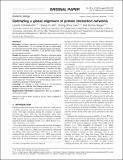Optimizing a global alignment of protein interaction networks
Author(s)
Ma, C.-Y.; Liao, C.-S.; Berger, Bonnie; Chindelevitch, Leonid
DownloadChindelevitch_2013-Optimizing global alignment.pdf (273.7Kb)
PUBLISHER_CC
Publisher with Creative Commons License
Creative Commons Attribution
Terms of use
Metadata
Show full item recordAbstract
Motivation: The global alignment of protein interaction networks is a widely studied problem. It is an important first step in understanding the relationship between the proteins in different species and identifying functional orthologs. Furthermore, it can provide useful insights into the species’ evolution.
Results: We propose a novel algorithm, PISwap, for optimizing global pairwise alignments of protein interaction networks, based on a local optimization heuristic that has previously demonstrated its effectiveness for a variety of other intractable problems. PISwap can begin with different types of network alignment approaches and then iteratively adjust the initial alignments by incorporating network topology information, trading it off for sequence information. In practice, our algorithm efficiently refines other well-studied alignment techniques with almost no additional time cost. We also show the robustness of the algorithm to noise in protein interaction data. In addition, the flexible nature of this algorithm makes it suitable for different applications of network alignment. This algorithm can yield interesting insights into the evolutionary dynamics of related species.
Availability: Our software is freely available for non-commercial purposes from our Web site, http://piswap.csail.mit.edu/.
Date issued
2013-09Department
Massachusetts Institute of Technology. Computer Science and Artificial Intelligence Laboratory; Massachusetts Institute of Technology. Department of MathematicsJournal
Bioinformatics
Publisher
Oxford University Press
Citation
Chindelevitch, L., C.-Y. Ma, C.-S. Liao, and B. Berger. “Optimizing a global alignment of protein interaction networks.” Bioinformatics 29, no. 21 (October 18, 2013): 2765-2773.
Version: Final published version
ISSN
1367-4803
1460-2059